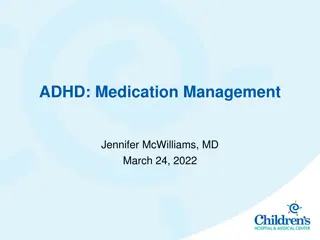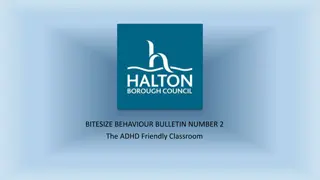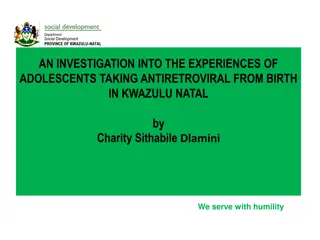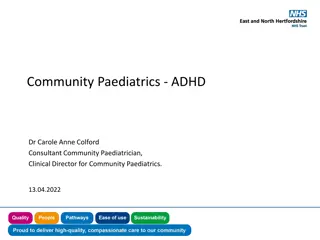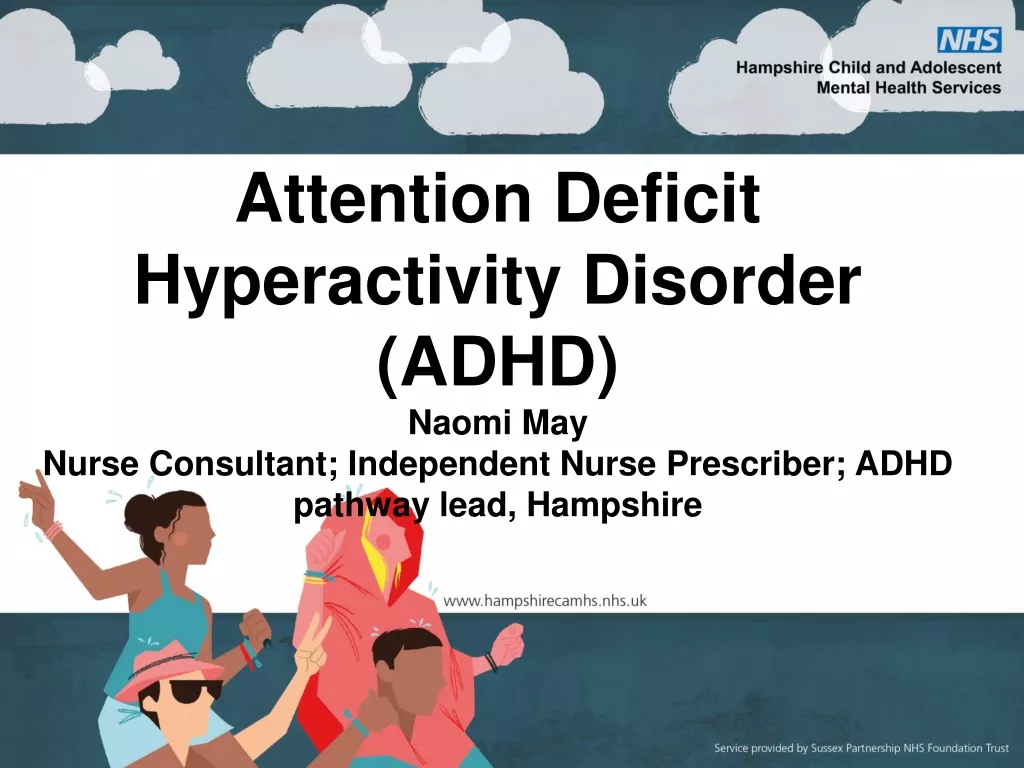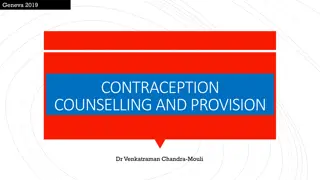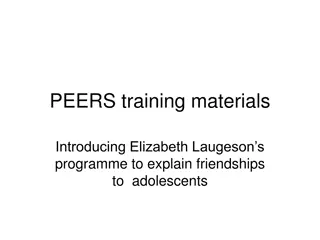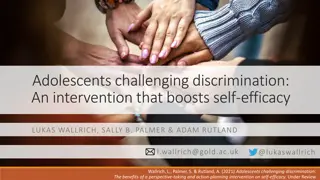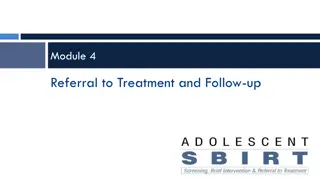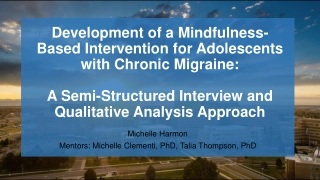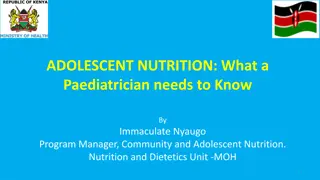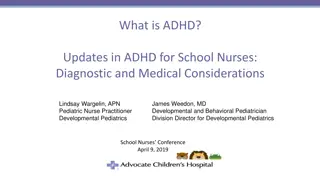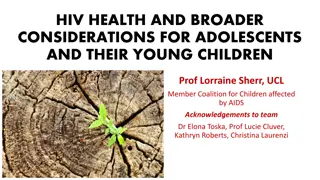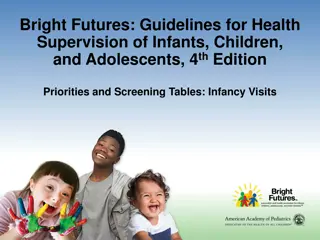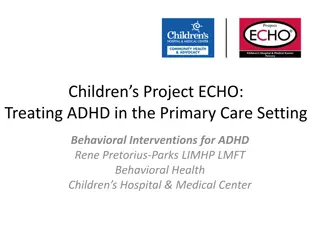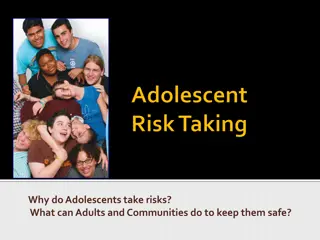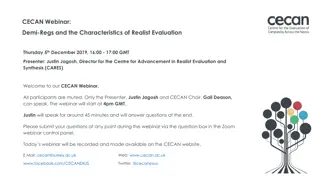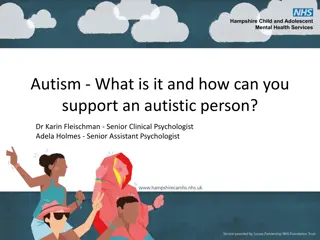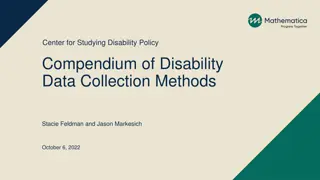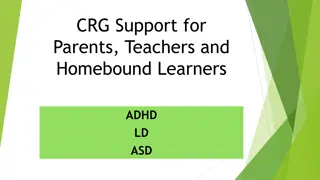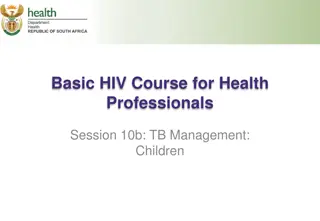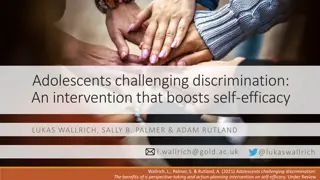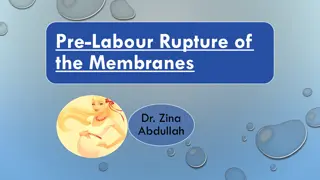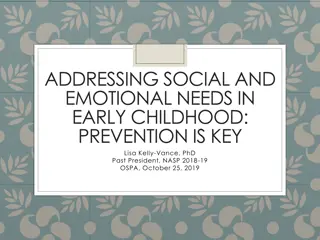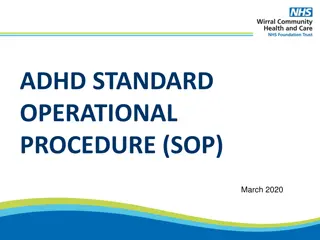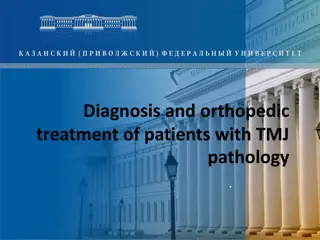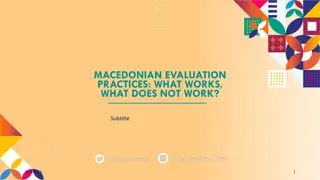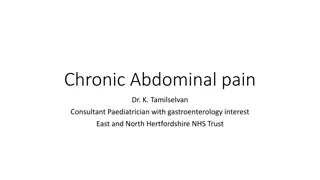Understanding ADHD Diagnosis and Evaluation in Children and Adolescents
This resource provides valuable insights into the diagnosis and evaluation of ADHD in children and adolescents. It covers important diagnostic aspects, criteria from DSM-5 for inattention and hyperactivity-impulsivity, and outlines when to make a referral for a formal evaluation. The content sheds light on the different components involved in an ADHD evaluation, offering a comprehensive overview for healthcare professionals and caregivers alike.
Download Presentation

Please find below an Image/Link to download the presentation.
The content on the website is provided AS IS for your information and personal use only. It may not be sold, licensed, or shared on other websites without obtaining consent from the author. Download presentation by click this link. If you encounter any issues during the download, it is possible that the publisher has removed the file from their server.
E N D
Presentation Transcript
Diagnosis and Evaluation of ADHD Joan Daughton, MD Child & Adolescent Psychiatry Children's Hospital and Medical Center Megan Carter, PsyD, LP Behavioral Health, Neuropsychology, Psychology Children's Hospital and Medical Center
February 24, 2022 Presenter Disclosures Consultant/ Speakers bureaus No Disclosures. Research funding No Disclosures. Stock ownership/Corporate boards-employment No Disclosures. Off-label uses No Disclosures.
Overview & Learning Objectives Discuss important diagnostic aspects regarding ADHD 1. Gain knowledge on when to make a referral for formal evaluation 2. Dive deeper into the different components of an ADHD evaluation 3.
ADHD DSM-5 Inattention: Six or more symptoms of inattention for children up to age 16 years, or five or more for adolescents age 17 years and older and adults; symptoms of inattention have been present for at least 6 months, and they are inappropriate for developmental level: 1. Often fails to give close attention to details or makes careless mistakes in schoolwork, at work, or with other activities. 2. Often has trouble holding attention on tasks or play activities. 3. Often does not seem to listen when spoken to directly. 4. Often does not follow through on instructions and fails to finish schoolwork, chores, or duties in the workplace (e.g., loses focus, side-tracked). 5. Often has trouble organizing tasks and activities. 6. Often avoids, dislikes, or is reluctant to do tasks that require mental effort over a long period of time (such as schoolwork or homework). 7. Often loses things necessary for tasks and activities (e.g. school materials, pencils, books, tools, wallets, keys, paperwork, eyeglasses, mobile telephones). 8. Is often easily distracted 9. Is often forgetful in daily activities.
ADHD DSM-5 Hyperactivity and Impulsivity: Six or more symptoms of hyperactivity- impulsivity for children up to age 16 years, or five or more for adolescents age 17 years and older and adults; symptoms of hyperactivity-impulsivity have been present for at least 6 months to an extent that is disruptive and inappropriate for the person s developmental level: 1. Often fidgets with or taps hands or feet, or squirms in seat. 2. Often leaves seat in situations when remaining seated is expected. 3. Often runs about or climbs in situations where it is not appropriate (adolescents or adults may be limited to feeling restless). 4. Often unable to play or take part in leisure activities quietly. 5. Is often on the go acting as if driven by a motor . 6. Often talks excessively. 7. Often blurts out an answer before a question has been completed. 8. Often has trouble waiting their turn. 9. Often interrupts or intrudes on others (e.g., butts into conversations or games)
ADHD DSM-5 In addition, the following conditions must be met: Several inattentive or hyperactive-impulsive symptoms were present before age 12 years. Several symptoms are present in two or more settings, (such as at home, school or work; with friends or relatives; in other activities). There is clear evidence that the symptoms interfere with, or reduce the quality of, social, school, or work functioning. The symptoms are not better explained by another mental disorder (such as a mood disorder, anxiety disorder, dissociative disorder, or a personality disorder). The symptoms do not happen only during the course of schizophrenia or another psychotic disorder.
ADHD DSM-5 Based on the types of symptoms, three kinds (presentations) of ADHD can occur: Combined Presentation: if enough symptoms of both criteria inattention and hyperactivity-impulsivity were present for the past 6 months Predominantly Inattentive Presentation: if enough symptoms of inattention, but not hyperactivity-impulsivity, were present for the past six months Predominantly Hyperactive-Impulsive Presentation: if enough symptoms of hyperactivity-impulsivity, but not inattention, were present for the past six months
ADHD Assessment Signs of ADHD may not be observable when the patient is in highly structured or novel settings, engaged in an interesting activity, receiving one-to-one attention or supervision, or in a situation with frequent rewards for appropriate behavior. Conversely, symptoms typically worsen in situations that are unstructured, minimally supervised, boring, or require sustained attention or mental effort. Core deficits include impairment in rule-governed behavior across a variety of settings and relative difficulty for age in inhibiting impulsive response to internal wishes or needs or external stimuli.
ADHD Assessment Parent Interview The parent interview is important to the assessment process. It is often difficult to confirm the diagnosis of ADHD by an examination with the child or adolescent alone, since some children and most adolescents with ADHD are able to maintain attention and behavioral control in the office setting. Both parent and child interviews are used to rule out other psychiatric or environmental causes of symptoms. Queries about family history of ADHD, other psychiatric disorders, and psychosocial adversity (e.g., poverty, parental psychopathology or absence, family conflict) are especially important because of their relationship to prognosis.
ADHD Assessment School School-related assessment is essential to obtain reports of behavior, learning, and attendance at school, as well as grades and test scores. Psychoeducational testing is indicated to assess intellectual ability and to search for learning disabilities that may be masquerading as ADHD or may coexist with ADHD. An informal clinical observation of the classroom and a less structured situation can provide important data regarding the child's behavior, the teacher's management style, and other characteristics of the academic environment.
Assessment Rating Scales Parent and teacher rating scales yield valuable information efficiently. The most used scales are the Vanderbilt and ADHD-5. Vanderbilt ADHD-5 Ages 6 to 12 Ages 5 to 17 Parent & Teacher Forms Parent & Teacher Forms Spanish & English available Spanish & English available Short and quick, but very checklisty , symptoms can easily be overreported More thorough but takes longer Includes items related to mood and other disruptive behaviors Does not ask about any other symptoms or behaviors
Assessment Medical Evaluation Medical evaluation should include a complete medical history and a physical examination within the past 12 months. History should include the patient's use of prescribed, over-the-counter, and illicit drugs. Vision or hearing deficits should be ruled out. If clinical or environmental risk factors are present, lead level should be measured. Thyroid function tests are indicated only in the presence of clinical findings.
ADHD Other Tests ADHD is a clinical diagnosis; there is no test for ADHD. Neuropsychological tests are useful to evaluate specific deficits but are not sufficiently helpful to be routinely performed. Also not typically covered by insurance EEG or neurological consultation is indicated only in the presence of focal signs or clinical suggestions of seizure disorder or degenerative condition. There are insufficient data to support the usefulness of computerized EEG measures (neurometrics or brain mapping), event-related potentials, or neuroimaging. Computerized tests of attention and vigilance (CPTs) are not generally useful in diagnosis.
Vanderbilt https://www.nichq.org/sites/default/files/res ource-file/NICHQ-Vanderbilt-Assessment- Scales.pdf
Scoring the Vanderbilt/ADHD-5 These scales should NOT be used alone to make any diagnosis. You must take into consideration information from multiple sources. Scores of 2 (occurs often) or 3 (occurs very often) on Symptom items (i.e., positive responses) contribute to an overall symptom count. On the Vanderbilt - scores of 4 or 5 on Performance questions reflect problems in performance To meet DSM-5 criteria for the diagnosis, one must have at least 6 positive responses to either the inattentive or hyperactive core symptoms, or both
When to Refer for Further Evaluation: Concerns of other behaviors or mood related symptoms that may be contributing to attention difficulties. If a diagnosis has been established but the patient is not responding to medication. Lastly, any time you are in doubt! Sometimes, more information is needed or you might want a second opinion
Behavioral Health Evaluation Thorough diagnostic interview Medical record review (if available) Collateral contacts Rating scales (parent, teacher, and self) Conners, Third Edition Behavior Assessment Scale for Children, Third Edition Comprehensive report is written and provided to the family Recommendations and therapy approaches to be discussed in the next session


